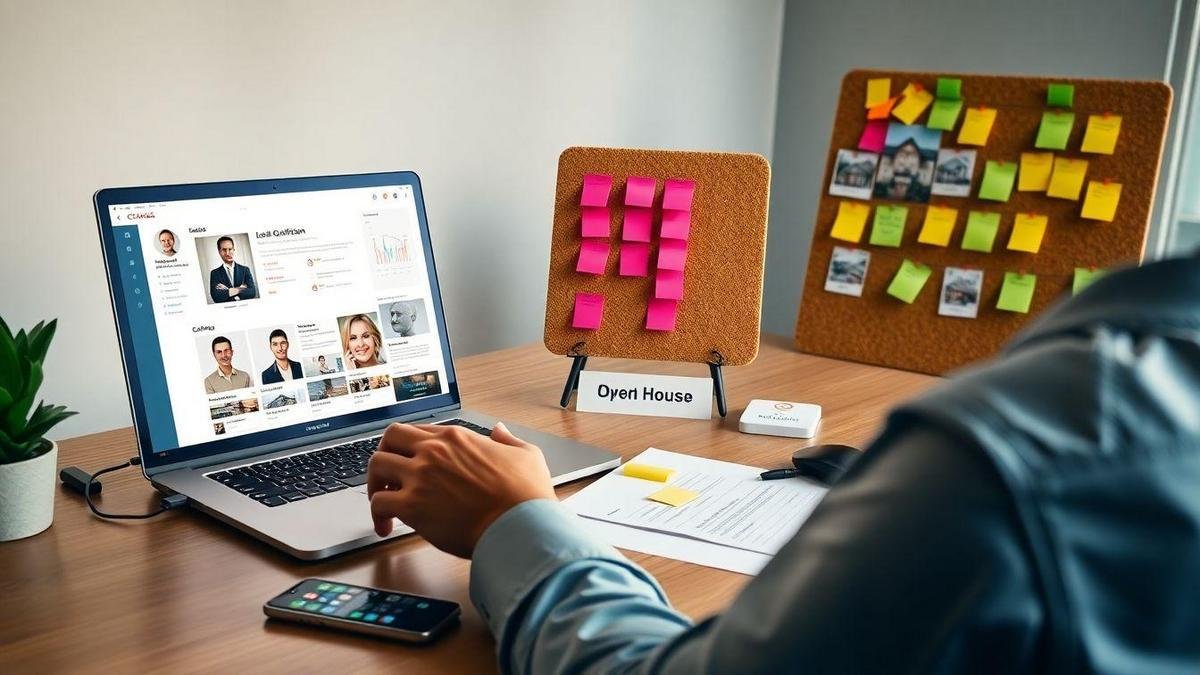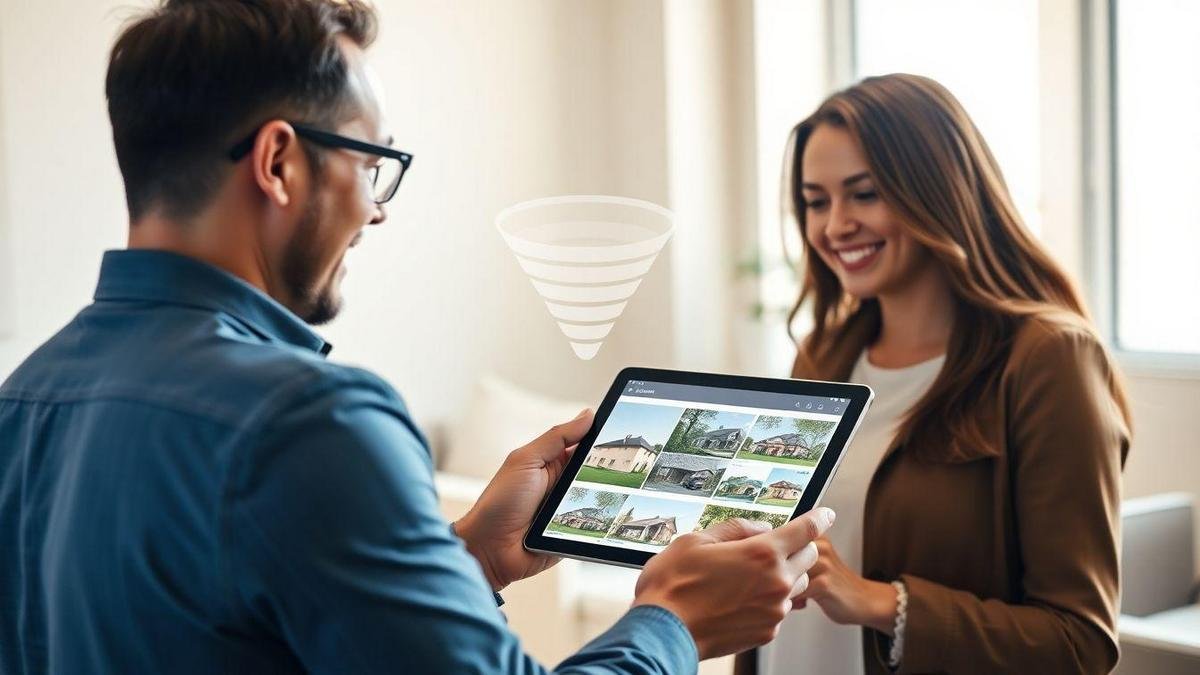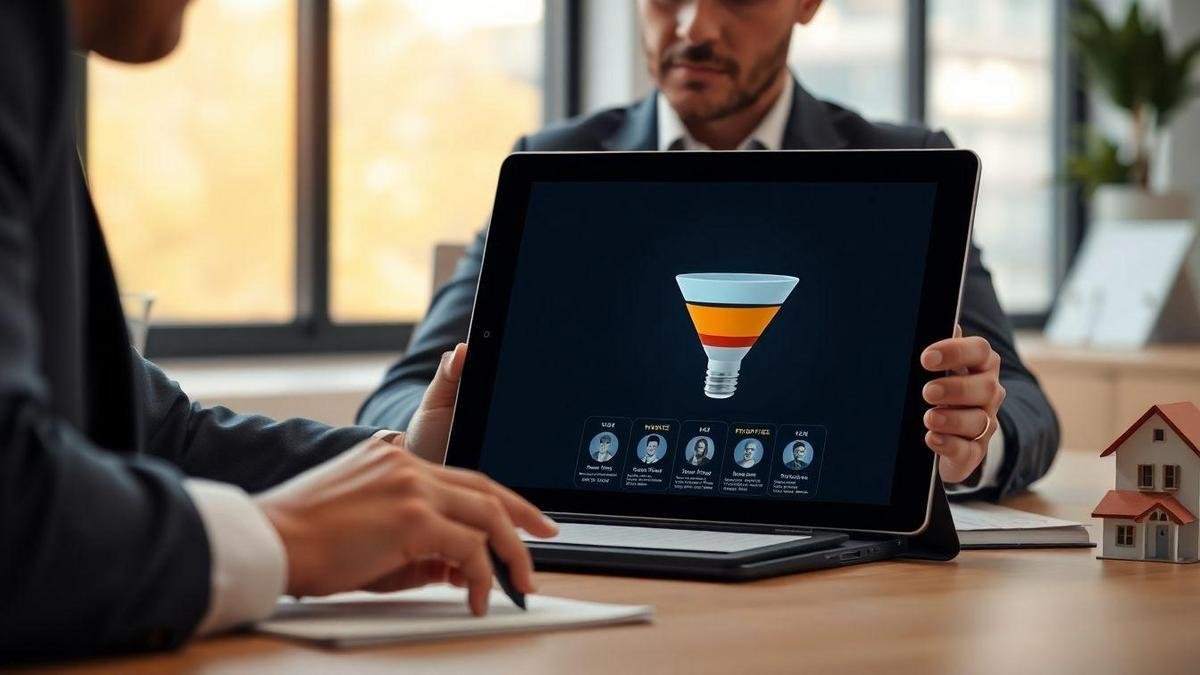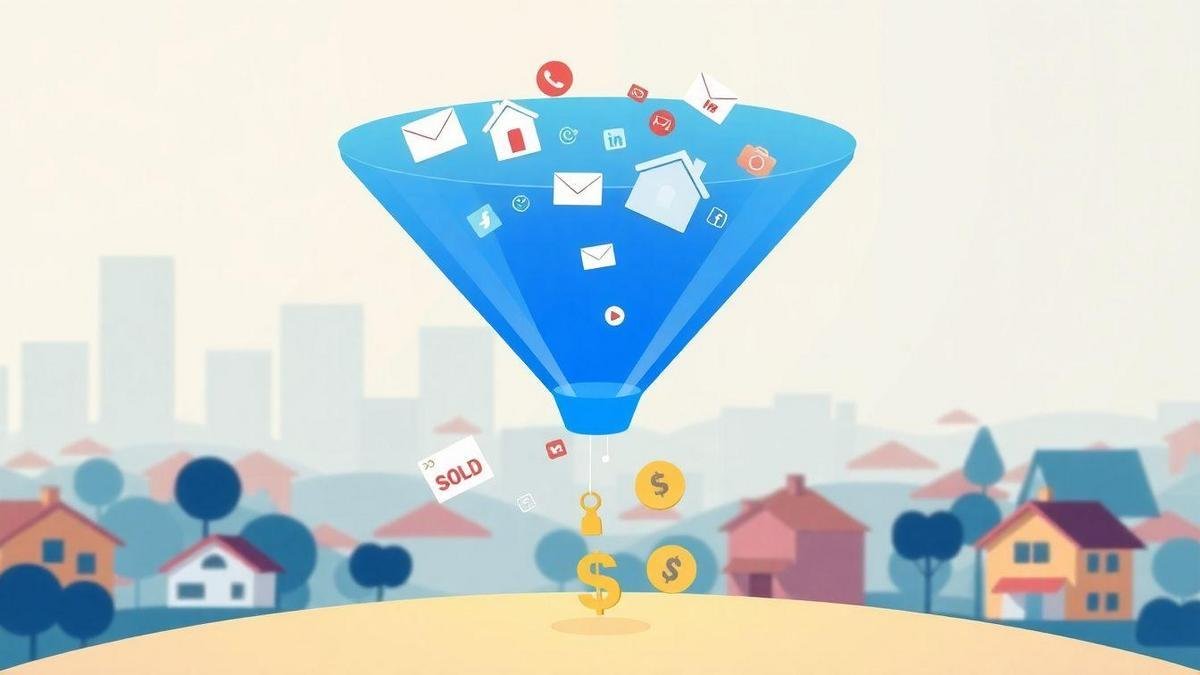Real estate sales funnel explained: core stages and goals for agents
Real estate sales funnel explained is a practical guide for agents that maps the funnel to business results. It outlines the core stages, key goals, KPIs, lead channels (online and offline), capture and qualification rules, nurture flows, CRM workflows, listing conversion tactics, pipeline management, buyer journey mapping, and follow-up/reactivation best practices. Read this to get clear, actionable steps to improve lead-to-close performance and tie them back to broader digital marketing strategies that drive measurable results.
Key takeaway
- Attract leads with targeted listings and ads (use paid search and social to accelerate launch) — see PPC tactics for listings
- Nurture leads with timely, relevant email/SMS and calls — pair with email marketing best practices
- Qualify prospects to focus on ready buyers using scoring and predictive signals
- Convert clients by guiding showings and offers with optimized listing pages and follow-up flows — optimize listings for lead capture with website optimization techniques
- Measure funnel steps to optimize results and prove marketing ROI

Real estate sales funnel explained: core stages
Treat the funnel like a roadmap with three stops: Attract → Engage → Convert. Each stage has a clear goal and concise tactics.
Definition of stages
- Attract
- Goal: drive traffic and brand awareness
- Tactics: social ads and geo-targeted posts, high-quality listing photos, local SEO, open houses, community events — combine local SEO with social content from a focused SEO approach and creative social media content for neighborhood reach
- Example: a Facebook neighborhood ad increases listing views in a week
- Engage
- Goal: turn visitors into qualified leads
- Tactics: email drips, chat on listings, virtual tours, targeted content, fast responses — coordinate email sequences with short videos from a video marketing plan for higher engagement
- Example: send a short video walkthrough and schedule a showing
- Convert
- Goal: close the deal and create referrals
- Tactics: tailored proposals, clear next steps, strong negotiation, post-sale check-ins for reviews/referrals — reinforce your brand and referral engine with a consistent branding approach
- Example: after closing, request a review and gain two referrals
How the funnel aligns with agent business goals
- Attract → brand visibility, listing views, wider contact list
- Engage → higher lead quality, faster appointments, better follow-up
- Convert → higher close rates, bigger average sale price, more referrals
Practical alignment: focus Attract for more listings; optimize Engage/Convert for faster closings. Small changes at Engage (faster replies, better follow-up) often move the needle faster than big top-of-funnel spends — pair those changes with website fixes from a lead-focused site strategy.
Key performance metrics to monitor
| Metric | What it measures | Why it matters / target |
|---|---|---|
| Website traffic | Volume of visitors | Shows reach; grow month over month |
| Leads per month | New contacts captured | Direct pipeline input |
| Lead conversion rate | Leads → appointments | Measures engagement effectiveness |
| Cost per lead (CPL) | Marketing spend ÷ leads | Controls budget efficiency — tie this back to your marketing ROI benchmarks |
| Lead-to-client rate | Leads → closed clients | Reflects sales effectiveness |
| Average deal value | Typical sale price | Impacts revenue planning |
| Days on market / time to close | Speed of transactions | Faster turns free capital |
| Email open / response rates | Engagement with outreach | Signals message resonance — improve with better email sequences |
| Referral rate | Clients who refer others | Low-cost growth signal |
Priority for a busy agent: Leads per month → Lead conversion rate → Lead-to-client rate → Average deal value.

Lead generation channels in the real estate sales funnel explained
Think of channels as tools. Some bring cold traffic, others warm referrals. Apply the real estate sales funnel explained to pick the right mix quickly.
Online sources: SEO, PPC, social
- SEO: build pages for local searches (e.g., “homes for sale in [neighborhood]”). Slow start, long-term value. Use neighborhood guides and property schema — see targeted tactics for property SEO in SEO tips for developers and brokers.
- PPC: rent immediate visibility on Google/Facebook for listing launches, open house sign-ups, market reports. Bid on high-intent phrases and tight geotargets — implement best practices from real estate PPC campaigns.
- Social: photos, short videos, reels, neighborhood tours. Video converts better than text—test boosted posts and retarget engaged users; use content ideas in social media content for real estate and amplify with YouTube short-form strategies.
Offline sources: referrals, open houses, local events
- Referrals: ask for introductions after closing; offer a small thank-you. Very high conversion.
- Open houses: capture contacts with sign-in apps; follow up within 24 hours.
- Local events: sponsor workshops or neighborhood talks to build trust and create ready-to-talk prospects.
Typical CPL benchmarks by channel
| Channel | Typical CPL (USD) | Quick pros | Quick cons |
|---|---|---|---|
| Organic SEO | $0–$50 (long-term) | Low ongoing cost, qualified | Slow start |
| Google PPC | $50–$200 | High intent, fast | Expensive in competitive markets |
| Facebook/Instagram Ads | $20–$150 | Good for listings & retargeting | Variable lead quality |
| Referral | $0–$30 | Very high conversion | Depends on relationships |
| Open House | $10–$100 | Local, immediate leads | Time and staging cost |
| Local Events | $5–$75 | Builds trust & brand | Attendance varies |
Tips to lower CPL: narrow targeting to core ZIPs, use lead magnets (market reports), retarget warm visitors first with techniques from retargeting campaigns that use AI.

Capture and qualification methods
The goal when someone lands on a page: capture interest, qualify intent, move best leads toward a viewing or call. Use clear headlines (e.g., Real estate sales funnel explained) to set expectations.
Best practices for capture forms and landing pages
- Headline clarity: e.g., “Book a viewing” or “Get a free market estimate”
- One clear CTA per page
- Above-the-fold simple form; mobile-first layout — follow mobile-first design principles to maximize conversions
- Social proof: reviews or recent sales near the form
- Fast load time and a short privacy note (“We won’t share your info.”)
- Progressive capture: ask minimal fields first, collect more later
- Promise a reply window and keep it
Ideal form flow:
- Offer value (guide, estimate, showing)
- Request name phone or email
- Deliver instant value (PDF or booking link)
- Ask for more details after first contact
Lead scoring rules (simple points system)
| Signal | Points | Notes |
|---|---|---|
| Submitted basic form | 10 | Baseline interest |
| Requested viewing / booked tour | 40 | High intent |
| Asked specific property/address | 30 | Targeted interest |
| Downloaded market report | 15 | Research interest |
| Multiple page views in 24 hrs | 10 per session | Engaged behavior |
| Price filter above property value | 20 | Budget match |
| Agent callback requested | 50 | Immediate action needed |
Thresholds: 0–30 = nurture; 31–70 = warm; 71 = hot → call within 1 hour. Apply time decay (reduce points 50% after 14 days). Automate owner assignment and CRM status changes. Consider feeding signals into predictive analytics models to refine scoring over time.
Minimum contact & property data to collect
Contact basics: full name, phone or email (one required), preferred contact time, how they heard about you (optional).
Property basics: buying or renting, desired location/address, budget range, bedrooms needed, timeline to move.
Optional: current property status, mortgage pre-approval, must-haves. Start with a short form and collect extras later.

Real estate lead nurturing strategies in the sales funnel explained
Lead nurturing is a conversation, not a campaign. Map content and cadence to top/mid/bottom funnel.
Email drip campaigns mapped to buyer journey
- Awareness: welcome neighborhood guide, market snapshot, FAQ
- Consideration: property matches, financing basics, virtual tour invites, case studies
- Decision: showing confirmations, negotiation tips, limited-time incentives, clear CTA to book a tour
Sample sequence for a new lead:
- Welcome neighborhood guide (Day 0)
- Market snapshot listing highlights (Day 3)
- Buyer guide financing checklist (Day 7)
- Personalized matches virtual tour invite (Day 14)
- CTA: schedule viewing (Day 21)
Keep emails short, one idea per message, human sign-off and photo. A/B test subject lines and use techniques from email marketing for real estate.
Multi-channel touchpoints: SMS, calls, retargeting
- Email: storytelling and longer content
- SMS: confirmations, time-sensitive invites (permission-based)
- Phone calls: high-touch for warm leads or to close appointments
- Social retargeting: keeps listings visible after site visits — implement retargeting sequences informed by AI-driven retargeting tips
Best practices: opt-in for SMS, call when lead score threshold met, sync messaging to avoid conflicting communication, personalize referencing viewed listings.
Recommended cadence (heartbeat approach):
| Stage | Typical Cadence | Primary Channel | Goal |
|---|---|---|---|
| Awareness | 1–2 emails in first 7 days; weekly retargeting ads | Email Ads | Build trust |
| Consideration | 1 email every 5–7 days; 1 SMS per major invite | Email SMS | Educate & engage |
| Decision | 2–3 touches in a week (SMS call email) | SMS Call | Book viewing / convert |
Rules: ask permission for SMS/calls at first contact, pause automation if lead requests direct contact, shorten intervals when lead score rises, limit SMS to ~3/week, retry calls three times over 48 hours.

CRM workflows to power the real estate sales funnel explained
Workflows automate routing, tasks, and follow-ups so agents spend time selling, not chasing.
Automated lead routing & task creation
Benefits: faster response, higher lead-to-appointment conversion, clear ownership.
Set rules: route by lead source, location, property type, agent availability. Create fallback rules and log handoffs.
Example: Zillow condo lead routes to the agent who handles downtown condos and creates a “Call within 10 minutes” task. Use a centralized CRM — consider options from our CRM recommendations to support routing and integrations.
Template messages & trigger-based alerts
- Templates: short, human, personalized (name, property, city). Keep templates for new lead, schedule confirm, showing follow-up, contract sent.
- Triggers: new lead → instant welcome; lead opens/clicks → notify agent; showing scheduled → confirmation & checklist.
Example sequence:
- Instant welcome SMS
- Follow-up email with relevant listings within 1 hour
- Agent call task same day
- Reminder SMS 24 hrs before showing
- Post-showing feedback email
Key integrations: MLS, calendar, phone systems
| Integration | Purpose | Examples | Best practice |
|---|---|---|---|
| MLS | Sync listings and property data | MLS feed, IDX | Map fields so updates auto-refresh saved searches |
| Calendar | Automate appointments and reminders | Google Calendar, Outlook | Two-way sync; auto-create events from CRM |
| Phone systems | Capture calls, click-to-call, recordings | RingCentral, Twilio | Enable call logging and tie calls to contact records |
Priorities: real-time MLS updates, synced calendar to avoid double-booking, phone integration to log calls and speed callbacks.

Conversion funnel — turning listing views into clients
Treat each listing like a machine: exposure → interest → engagement → decision. The listing hands the baton to the agent who runs the close.
Listing presentation and buyer consultation best practices
- First impression: one-sheet with key facts, comps, concise value pitch; high-quality photos and floor plans
- Tell a story: lifestyle angles (commute, schools, entertaining, investment)
- Set expectations: timeline, next steps, communication cadence; ask permission to follow up
- Ask sharp questions and listen; repeat back priorities to build trust
- Close the consultation with a clear next step and a deadline to keep momentum — anchor your pitch in a consistent branding strategy.
Online listing optimization & CTAs
- Headline: include beds, baths, neighborhood, strongest selling point
- Visuals: lead with the best photo; include virtual tour and short video — add a short clip guided by video marketing techniques for higher click-throughs
- Description: short paragraphs, highlight unique amenities, use local search terms
- Mobile & speed: ensure fast mobile load times — apply mobile-first optimizations
- CTAs: Schedule a tour, Request the disclosure, Get the price history, Make an offer (place at top and bottom)
CTA table:
| CTA text | Purpose |
|---|---|
| Schedule a tour | Move viewer to in-person/virtual visit |
| Request more info | Capture contact details |
| Make an offer | Direct path to conversion |
| Get instant valuation | Engage sellers, create seller leads |
Simple A/B tests to improve listing-to-lead conversion
- Test main photo: living room vs. curb appeal → track CTR and inquiries
- Test headline length: short vs. descriptive → track time on page and leads
- Test CTA wording & placement → Schedule a tour vs. Book your viewing now
- Test video vs. no video → track engagement and contact rate — use insights from YouTube and short video strategies
- Test price visibility: show price vs. contact for price → measure inquiry quality
Track CTR, lead rate, time on page, and showing requests. Run tests long enough for solid data.

Pipeline management within the real estate sales funnel explained
A smart realtor treats the pipeline like an engine—monitor deals, schedule next actions, and avoid breakdowns. Real estate sales funnel explained ties process to everyday practice.
Tracking stages from listing to closing
| Stage | Key actions | Typical timeframe |
|---|---|---|
| Lead / Prospecting | Capture lead, pre-qualify, schedule visit | Days–weeks |
| Listing / Marketing | Sign, photos, market launch | 1–2 weeks |
| Showings / Tours | Open houses, private showings | Ongoing |
| Offer Received | Collect offers, advise seller | 1–7 days |
| Negotiation | Counteroffers, terms agreed | 1–7 days |
| Under Contract | Earnest money, inspections, financing | 2–6 weeks |
| Contingencies Clear | Repairs, appraisal, conditions | 1–3 weeks |
| Closing | Final docs, funds transfer, keys | Day of closing |
Record concise notes at each stage. Short updates beat long, late reports.
Forecasting using deal value, age, and historical win rates
Steps to build a weighted forecast:
- List each active deal with Deal Value
- Assign stage probability using historical win rates
- Adjust probability for Age (reduce for stalled deals)
- Weighted Value = Deal Value × Adjusted Probability
- Sum weighted values for the forecast
Example:
- Deal A: $300,000 @ Offer Received (50%) → Weighted = $150,000
- Deal B: $200,000 stuck under contract (adj. 75%) → Weighted = $150,000
Total short-term forecast = $300,000
Revisit assumptions weekly; keep a simple CRM or spreadsheet with Value, Stage %, Age adjustment, Weighted Value — enhance accuracy with predictive analytics where possible.
Weekly pipeline review agenda (15–30 minutes)
- Quick dashboard review (top-line forecast)
- Top 5 deals deep dive (owners report next steps)
- Aged deals triage (keep/rework/remove)
- Action list with owners and deadlines

Mapping the buyer journey across stages — real estate sales funnel explained
View the buyer journey as a road trip: stops matter and the right map saves time. Use the phrase real estate sales funnel explained to align teams.
Actions & content by stage
- Awareness: short videos, social posts, local ads, free guides (e.g., “How to start home buying”) — pair social posts with content calendars from social media content ideas
- Consideration: virtual tours, downloadable specs, webinars, case studies
- Decision: clear CTAs (book viewing, apply for financing), urgency tools, personalized follow-up
Aligning assets to buyer personas
| Persona | Awareness (Top) | Consideration (Middle) | Decision (Bottom) |
|---|---|---|---|
| First-time buyer | Short explainer videos, checklist | Mortgage calculator, neighborhood guide | Step-by-step buying packet, CTA to book viewing |
| Investor | Market trend snippets, income snapshots | ROI calculators, rental comps | Offer-ready templates, negotiation guide — support investor content with investor-focused content marketing |
| Downsizer | Lifestyle videos, amenity highlights | Floor plans, testimonials | Concierge visit scheduling, downsizing checklists |
Collect which asset led to engagement to refine the approach.
Data points to collect for buyer journey mapping
- Acquisition source, contact details, property preferences, budget/financing status, timeline, intent signals (pages viewed/downloads), interaction history, objections, lead score, persona tag.

Follow-up sequences and reactivation best practices
Cold leads need steady, useful touches—a drip reactivation campaign mixes emails, SMS, short videos, and voicemails with clear CTAs and small value promises.
Drip reactivation cadence example
Segment by last contact, source, interest. Example cadence:
Day 0 (friendly nudge), Day 3 (value send), Day 10 (social proof), Day 30 (special offer), Day 60 (market update), Day 120 (final win-back).
Message types: short market snapshot email, SMS question (“Still looking?”), 20–30 second agent video, voicemail if appropriate. Win-back hooks: market updates, exclusive showings, valuation offers, success stories — combine channels and creatives from your email, video and retargeting toolkits like those linked earlier.
Metrics to track for reactivation
| Metric | How to calculate | Practical benchmark |
|---|---|---|
| Response rate | Replies ÷ messages sent | 10–30% (varies by channel) |
| Appointment rate | Appointments set ÷ responses | 20–50% |
| Conversion | Closed deals ÷ re-engaged leads | 1–5% |
Track opens, clicks, and reply types. Pivot channels where responses rise.
Rules for long-term follow-up and re-engagement
- Be predictable but not annoying; stop if lead asks to pause
- Rotate channels: email, SMS, social, occasional calls
- Keep messages short and single-CTA
- Log every touch (date, channel, response)
- Personalize with last-seen property or neighborhood
- Use time-based triggers (market change, new listing, price drop, anniversaries)
- Exit rule: after 12–18 months of varied touches with no response, move to low-touch nurture list
- Respect compliance: opt-outs and local messaging laws
- Measure and tweak subject lines, length, and send times
Conclusion
Real estate sales funnel explained becomes a usable playbook when agents focus on three stops—Attract, Engage, Convert—and map each to tactics, KPIs, and repeatable workflows. Small fixes at Engage (fast replies, tight forms, short templates) often outperform larger top-of-funnel spends. Measure leads per month, lead conversion rate, lead-to-client rate, and average deal value. Use lead scoring and time-based triggers to prioritize action; forecast with weighted deal values and review the pipeline weekly.
Execution beats theory: run short A/B tests on photos, CTAs, and timing; route leads automatically; use short human templates; and mix email, SMS, and calls at the right cadence. Keep the human touch where it counts. Small, steady changes compound into reliable closings.
For more practical guides and real-world tactics, read more at https://realhubly.com.

One response
[…] listing visibility by targeting people who already showed interest. This guide explains how to segment audiences, spot hot leads, use dynamic retargeting, run email and Facebook remarketing, automate through your […]